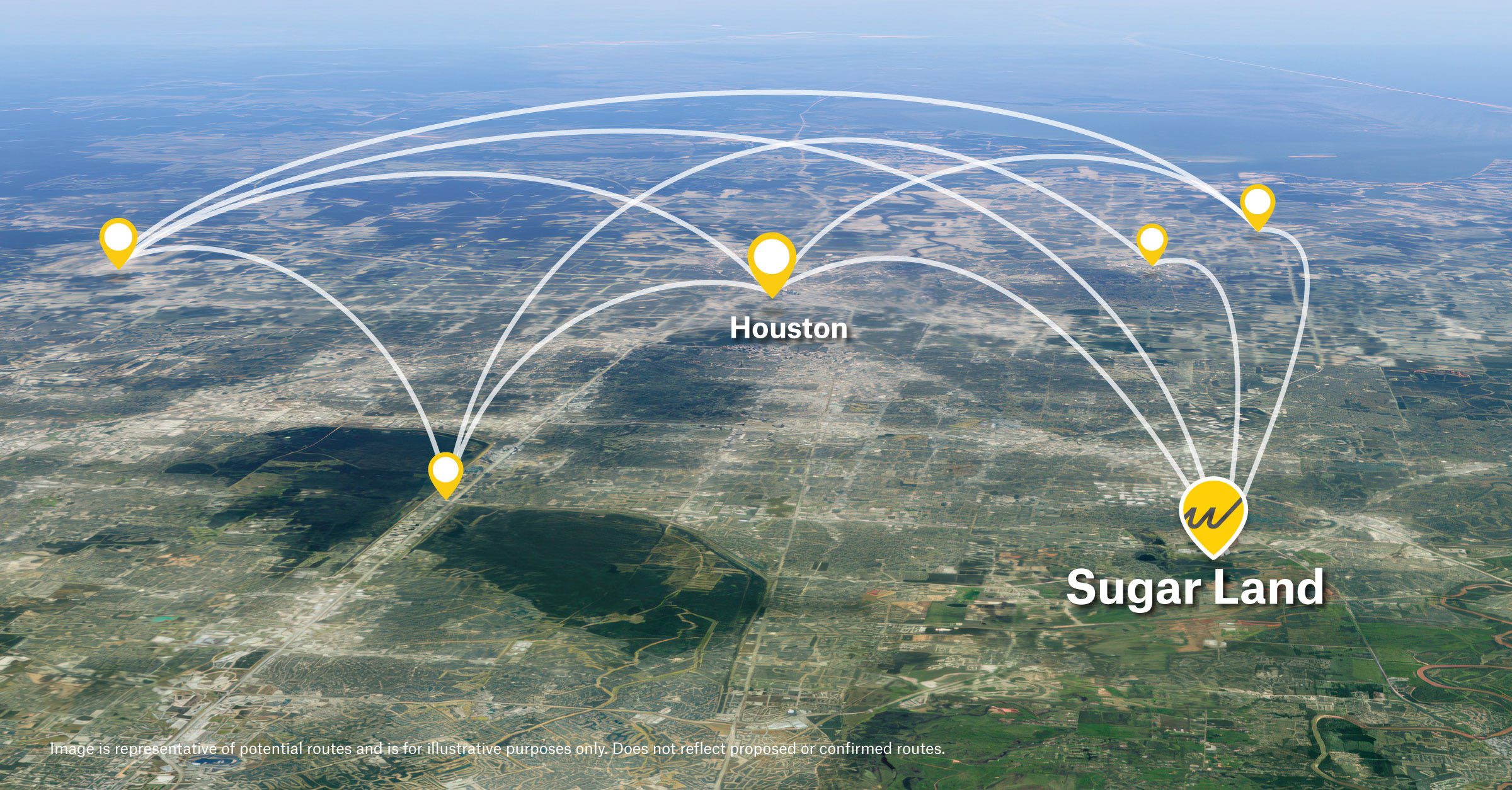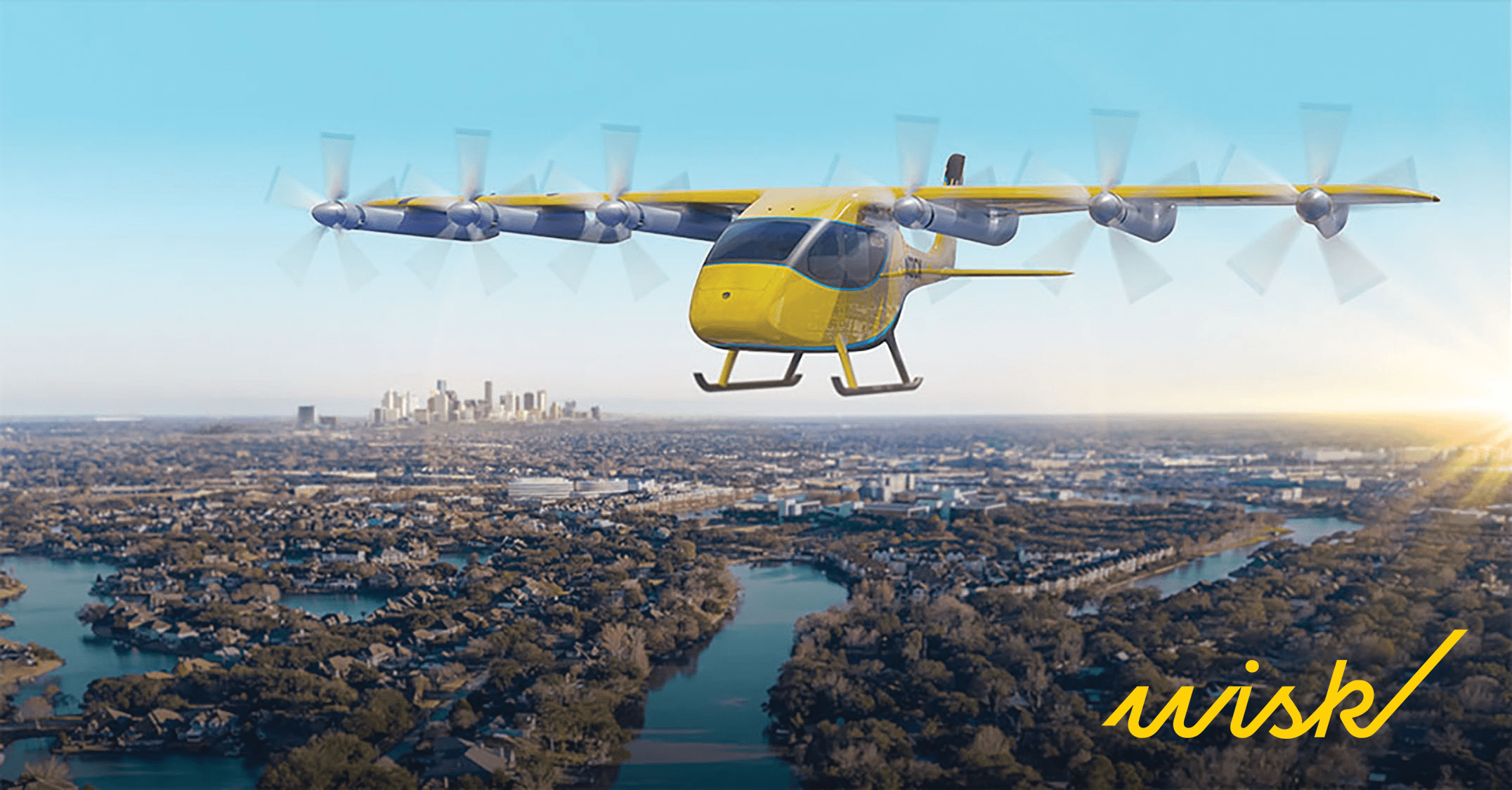
 Wisk plans to build vertiport at Texas airport to site Houston-area eVTOL network
Wisk plans to build vertiport at Texas airport to site Houston-area eVTOL network
By DRONELIFE Features Editor Jim Magill
Autonomous flying taxis carrying passengers are expected to be winging their way across the skies above the greater Houston area within the next several years, as the result of a partnership between advanced air mobility (AAM) company Wisk and the city of Sugar Land, Texas.
Under their agreement, Wisk and Sugar Land will work jointly to identify and assess a location at the Sugar Land Regional Airport to develop a vertiport for Wisk’s autonomous air taxi operations. Preliminary plans call for Wisk to establish a base of operations for electric vertical take-off and landing (eVTOL) aircraft by the end of this decade.
The airport, located about 24 miles southwest of downtown Houston, is being planned to serve as the hub of a wider eVTOL network across the greater Houston region.
“We are looking at other existing aviation infrastructure in the Houston region to connect to Sugar Land and across the Houston airport system,” Emilien Marchand, Wisk’s director of ecosystem partnerships, said in an interview. “Sugar Land is really the first domino, if you will.”
Wisk, based in Mountain View, California, which has been developing self-flying eVTOL air taxis for more than a decade, has conducted 1,800-plus flights, through five generations of aircraft. With its Generation Six vehicles, the AAM company hopes to begin offering commercial flight operations by 2030 or sooner.
The company is going through a prototype phase, as it seeks FAA certification for its latest generation of aircraft. “At the end of last year, we did a public demonstration at the Festival of Flight in Long Beach,” Marchand said. The event marked the first public demonstration of an autonomous AAM flight in the region, which Wisk considers one of its most important potential markets.
Unlike some of its competitors that plan to begin offering consumers flights in piloted eVTOL air taxis, before introducing fully autonomous service, Wisk’s plan is to begin letting its passengers experience flights aboard pilotless aircraft right off the bat.
“Our strategy is to go straight to autonomy so that we can be the first company to scale operations,” Marchand said.
Beyond establishing a vertiport base in Sugar Land, Wisk is in the process of studying potential locations for landing and take-off sites throughout the greater Houston area, in key destination areas such as The Woodlands, a master-planned community north of the city, the Galleria area, a popular shopping and entertainment mecca and the Energy Corridor, along Interstate 10 west of downtown Houston.

The company is also looking for a site to locate its Fleet Operations Center, which will house what Wisk calls its multi-vehicle supervisors, the personnel on the ground who will oversee the flight operations of its fleet of pilotless aircraft.
Marchand said the Wisk air taxi service will offer a new and exciting alternative to ground transportation, carrying passengers to and from the airport in a fraction of the time. “The ground infrastructure is getting increasingly pressured. There’s more and more traffic, so what we want to be is part of the solution, be one element that supports alleviating that congestion by being a complementary mode of transport,” he said.
The aircraft will be able to comfortably carry four passengers and their baggage. The cost of the service will be based on the Uber Black model, at an average of around $3 per passenger mile.


Sugar Land City Manager Mike Goodrum said the agreement with Wisk stems from the city’s forward-looking vision. In its most recent master plan for the airport, the city focused on two areas of innovation, the potential that the aircraft of the future would be powered by electricity and the need to develop an AAM plan.
He said that when Wisk approached the city with its plans for a vertiport about a year ago, the company’s plans aligned with the city’s vision. “We’re agreeing that it’s going to be a priority for both of us; that we’re both going to put time, effort, blood, sweat, tears into it,” he said.
The city hopes to provide Wisk with enough space to establish vertical landing and takeoff spots, as well as infrastructure for charging the aircraft. The city is also working with CenterPoint, the local electric utility company, to ensure that the site is provided with enough power to meet Wisk’s needs.
Goodrum said it hasn’t been decided whether the vertiport will require the construction of its own terminal building or if Wisk passengers will use the main airport terminal.
He hopes that the vertiport could be up and running as early as 2028 and said the plan might evolve to include the construction of future eVTOL take-off and landing sites, as well as locating the fleet operations center within the city limits.
The final cost of the project is yet to be determined, but Goodrum said the city’s portion of the project funding come out of economic development funds, financed through either a sale tax or through grants, rather than through a property tax increase.
Asked whether the flying public is ready to board an aircraft without a pilot on board, Goodrum said, “I’ll tell you, we’ve received a ton of excitement about it, so there’s plenty of people that are asking when can they get on one of these things. And so, I do think the interest will be there.”
Read more:

 Jim Magill is a Houston-based writer with almost a quarter-century of experience covering technical and economic developments in the oil and gas industry. After retiring in December 2019 as a senior editor with S&P Global Platts, Jim began writing about emerging technologies, such as artificial intelligence, robots and drones, and the ways in which they’re contributing to our society. In addition to DroneLife, Jim is a contributor to Forbes.com and his work has appeared in the Houston Chronicle, U.S. News & World Report, and Unmanned Systems, a publication of the Association for Unmanned Vehicle Systems International.
Jim Magill is a Houston-based writer with almost a quarter-century of experience covering technical and economic developments in the oil and gas industry. After retiring in December 2019 as a senior editor with S&P Global Platts, Jim began writing about emerging technologies, such as artificial intelligence, robots and drones, and the ways in which they’re contributing to our society. In addition to DroneLife, Jim is a contributor to Forbes.com and his work has appeared in the Houston Chronicle, U.S. News & World Report, and Unmanned Systems, a publication of the Association for Unmanned Vehicle Systems International.
Miriam McNabb is the Editor-in-Chief of DRONELIFE and CEO of JobForDrones, a professional drone services marketplace, and a fascinated observer of the emerging drone industry and the regulatory environment for drones. Miriam has penned over 3,000 articles focused on the commercial drone space and is an international speaker and recognized figure in the industry. Miriam has a degree from the University of Chicago and over 20 years of experience in high tech sales and marketing for new technologies.
For drone industry consulting or writing, Email Miriam.
TWITTER:@spaldingbarker
Subscribe to DroneLife here.




